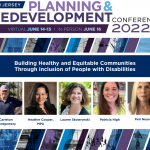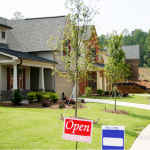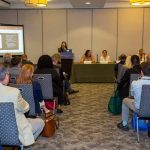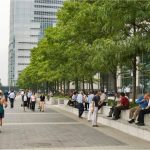New Jersey Future Blog
Walking the Talk: Planning for Places that Actualize Equity and Inclusion
July 8th, 2022 by Kimberley Irby
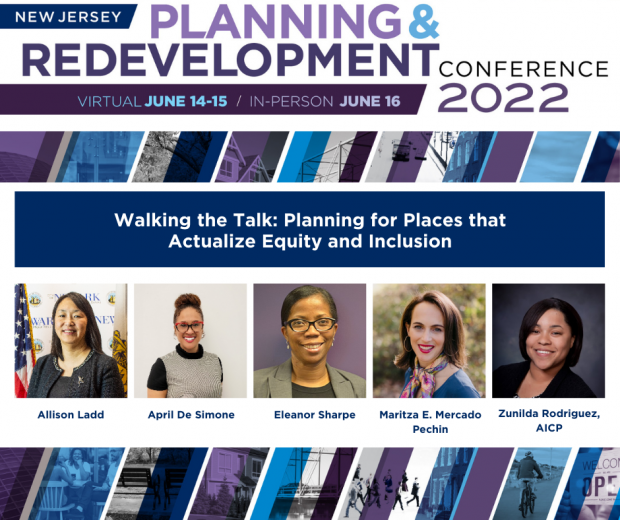 “In this era of racial reckoning, especially triggered by the murder of George Floyd, we have to pause and ask what our role is as a profession, what responsibility we have had in creating the societies in which we live, and how we rectify [problems] with an equity lens,” stated Eleanor Sharpe, deputy director for planning and zoning in the City of Philadelphia, a panelist in the first plenary session of the 2022 NJ Planning and Redevelopment Conference, hosted by New Jersey Future and and the New Jersey chapter of the American Planning Association.
“In this era of racial reckoning, especially triggered by the murder of George Floyd, we have to pause and ask what our role is as a profession, what responsibility we have had in creating the societies in which we live, and how we rectify [problems] with an equity lens,” stated Eleanor Sharpe, deputy director for planning and zoning in the City of Philadelphia, a panelist in the first plenary session of the 2022 NJ Planning and Redevelopment Conference, hosted by New Jersey Future and and the New Jersey chapter of the American Planning Association.
The virtual plenary, titled Walking the Talk: Planning for Places that Actualize Equity and Inclusion, served as a follow-up to the previous year’s plenary called the Geography of Equity and Inclusion, which covered a big picture view of spatial segregation in the nation and in New Jersey specifically, as well as how we could mitigate it. The goal for this year’s plenary was to clarify what the planning and redevelopment community can and should do to achieve equity and inclusion in our communities.
The panel, moderated by Zunilda Rodriguez, senior associate at Nishuane Group, featured four distinguished speakers, including Sharpe; Maritza E. Mercado Pechin, deputy director of the Office of Equitable Development in the City of Richmond, VA; April de Simone, principal at Trahan Architects and co-founder of designing the WE; and Allison Ladd, deputy mayor and director of the Department of Economic and Housing Development in the City of Newark. During this plenary, speakers emphasized the importance of building trust with historically marginalized communities and establishing a robust process for their involvement throughout the stages of development or redevelopment, from planning to implementation.
How can we support accountability and transparency at the local level?
In response to this first question posed by Rodriugez, Mercado Pechin offered an example from the City of Richmond, citing a transportation policy guide that shared the blunt history of inequitable transportation projects, and thus, set the stage for choosing projects that could help remedy past mistakes. Later on, Pechin highlighted the legitimate concern of displacement from a project that will reconnect a community previously severed by a highway, and said that her office is examining solutions, such as ensuring there are more homeownership opportunities.
De Simone, a New York-based architect who co-led a national exhibit project called Undesign the Redline, reinforced the point that understanding historical context is necessary to avoid perpetuating inequitable outcomes, especially through projects that aim to undo the mistakes of the past, like highway capping. She reminded us not to assume that “just because we see development happening [in historically marginalized communities]… that the systemic conditions of inequity and disparities of poverty, health, and wealth-building opportunities are solved.”
How can we begin to rebuild trust with communities that have been left behind with empty promises for decades?
Several speakers brought up the challenges of building trust with the community and the audience asked for suggestions to tackle them. Sharpe, with the City of Philadelphia, urged planners to “listen more and talk less” when engaging with the public, noting that just hearing and acknowledging people is half of the work. Beyond this, Ladd, with the City of Newark, underscored the ability to adapt based on what the community is saying, as well as the need to be consistent with execution (i.e., following through on what one says they’re going to do). Ladd also acknowledged that “sometimes the listening and hearing parts are challenging, but we have to hear it even when it’s aggressive or uncomfortable, because that friction is actually where change happens.”
How can we thread equity and inclusion into local planning and/or processes?
Throughout the discussion, panelists echoed Sharpe’s saying, “slower is faster,” emphasizing that good community engagement requires time and deliberate, intentional focus. Sharpe also illustrated that effective engagement can empower communities to have a meaningful role in the creation of projects that will affect them. For example, she referred to the creation of Philadelphia’s Citizens Planning Institute, which educates cohorts of residents on planning and zoning, enabling them to translate technical aspects of government projects to their neighbors and assuage their concerns.
Additionally, Mercado Pechin shared that the City of Richmond used a similar community ambassador mechanism during their master plan process. All panelists agreed on the importance of compensating community volunteers for their time, both to ensure a socioeconomically diverse group and to affirm that insights from their lived experiences are just as valuable as the work they pay consultants to do.
To ensure equity and inclusion in community redevelopment, the panelists suggested that we intentionally engage in a way that brings different people to the table, especially those who have been historically left out. Though this can be challenging when trust is lacking, it is critical to build, or rebuild, a mutually beneficial relationship. Sharpe continually emphasized we are all learning and that there is no easy answer or silver bullet. Nevertheless, Sharpe reminded us that, “These are exciting times. There is a lot of opportunity as the world is shifting and changing, and our profession can show up and make our mark.”
Related Posts
Tags: communities, community, Development, equity, geography, geography of equity and inclusion, inclusion, Local Planning, New Jersey planning and redevelopment conference, planning, rebuild

